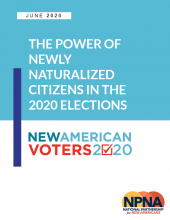The Power of Newly Naturalized Citizens in the 2020 Election
Newly naturalized citizens in ten states have the power to elect the next President of the United States. In these states--Michigan, Florida, New Hampshire, Pennsylvania, Nevada, Minnesota, Wisconsin, Arizona, Georgia, and Texas--when compared to the margin of victory for the 2016 presidential election, New American Voters have the largest likelihood of tipping the scale and being the decider of who will occupy the White House for the next four years. This multi-racial, multi-generational, and slightly majority women group of naturalized citizens represent a potential voting bloc that can also decide who controls the U.S. Senate by voting in states like Arizona, North Carolina, Colorado, Maine, Michigan and Georgia.
These potential voters are a substantial but only part of the larger group of new citizens who have naturalized since 2014. By the time of the 2020 presidential and Senate elections, they can total an estimated 5.3 million. However, the critical factor for newly naturalized citizens to use this political power and impact is registration and turnout. Newly naturalized citizens have lower voter registration and turnout rates than U.S.-born citizens.¹ This means that voter mobilization efforts specifically targeting recently naturalized citizens are necessary.
Iñiguez-López,D. (2020, June). The Power of Newly Naturalized Citizens in the 2020 Election. National Partnerships for New Americans. http://newamericanvoters2020.org/assets/2020/06/NAV-REPORT-2020-UPDATED.pdf

